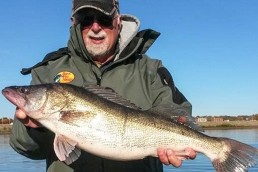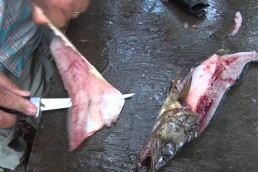Spring is Giant Walleye Time on the Mississippi River
SHARE THIS POST
As the river opens up from spring rains and a warming sun, anglers will begin another year dreaming of river giants tugging on the end of their line. In the Quad Cities, we have a strong winter tailwater fishery of walleyes and saugers. As the river warms into the 40s, walleyes begin to appear more often in the livewells of anglers. For those anglers looking for a fish of a lifetime, now is the time to strike.
Finding giants
To catch a giant walleye on the Illinois and Iowa portions of the Mississippi River, which I define as a fish over 10 pounds, you should fish differently than you would if you were trying to catch a limit for the frying pan. That is not to say you can’t catch one in the tailwaters in late March, but anglers who consistently find the giant walleyes are not up playing bumper boats with guys trying to limit on eaters. Big fish move differently, feed differently and hang out in different areas than you might be accustomed to trying.
The first thing to consider is location. If you are not fishing near large fish, nothing else matters. The biggest driver for large fish this time of year is breeding. Large female walleyes still feed, but minimally. It is secondary to relieving themselves of the hundreds of thousands of eggs each large fish carries. To find them, you have to think like you have a full stomach at Thanksgiving dinner or maybe ask advice from your wife about how she felt when she was nine months pregnant (or maybe not!).
First, these fish are not in fast current. Fish of this size do not want to spend their energy fighting the current for a meal. The Thanksgiving dinner analogy explains that reasoning. So, tailwater areas are typically not a hangout once spring flows begin. While there are low-current areas within the tailwater areas, usually the large walleyes are not there in significant numbers. Look for areas adjacent to spawning beds, such as a backwater, side channels or other low-flow area.
One of my favorite spots in Pool 14 is a boat marina. As boats rush out of the marina to get to the tailwater areas, they pass by many giant walleyes. If you are not sure where the spawning areas are, just look for the armada of boats away from the tailwaters. Usually the first good outside bend a mile or two below the tailwater is a strong possibility. Composed of gravel or mussel beds, usually 10 to 20 feet deep, these are the key spots to check. If you can catch larger, mature male walleyes there (fish over 20 inches), you found it. This time of year, a slight push on their bellies will let you know they are males. Males are there at least a week before the females shows up.
Go where it’s warm
Another spot to try is a hot-water discharge if you are fishing in an urban or industrial area, particularly if there is a long cold front. Industrial areas can raise pockets of water a degree or two, which might attract those females as they warm their bellies. Typically, you will not find a lot of males in these areas. Similar areas with these conditions include mud flat in a secluded backwater, often in 3 feet of water or less and many times in flooded grass. I know many early season bass anglers pitching jigs have accidently found themselves fighting a walleye from those shallow waters.
Are you enjoying this post?
You can be among the first to get the latest info on where to go, what to use and how to use it!
Finally, as the spawn approaches, fish those current breaks adjacent to the spawning beds. A number of larger females will stage up on current breaks on the main channel, especially when flows are lower. As usual, flow dictates everything while fishing the Mississippi River.
Small baits for big fish
When it comes to baits, think small. Ringworms, small crankbaits and swimbaits are the go-to baits prespawn. The fish are not aggressively feeding during this period. A light snack should be your best approach. Your bait may have to go by 50 fish before one decides to take a quick bite. Remember, the fish are not in feeding mode at this time. While large swimbaits can also work this time of year, they typically catch more males. Although male walleyes have been known to grow to 25 or 26 inches in Pools 12 to 14, so it is not exactly a bad catch.
Once the spawn has occurred, the females will disappear to most anglers… but they can be found. The larger walleyes will switch from spawning to feeding mode after a few days, which means aggressive feeding if you can find them. Backwaters where abundant forage, little current and some extra warmth in the water are a great place to start. This could be in a nearby backwater or 20 miles down the pool.
Again, flows dictate a lot of those decisions. You can step up the size of your baits at this time too. Big swimbaits have been the ticket for largemouth bass fisherman these past few years in the early spring, but your larger walleyes will also aggressively take those baits. It may not be the conventional way to catch walleyes, but it does work on larger fish.
This post-spawn pattern will last a few weeks, but eventually summer will arrive and the “normal” patterns will return for the rest of the year. If you are after that fish of a lifetime, mid-March to early April is the time to get on the river as record-size fish become predictable for a few short weeks.
MWO
SHARE THIS POST
Did you enjoy this post?
You can be among the first to get the latest info on where to go, what to use and how to use it!
Jeremiah Haas
As a full-time fisheries biologist on the Mississippi River, Jeremiah Haas is intimately tied to the outdoor resources surrounding the greater Quad Cities area and the Upper Mississippi River Basin. An accomplished hunter, fisherman and writer, Haas offers unique insight and perspective to MidWest Outdoors readers.



